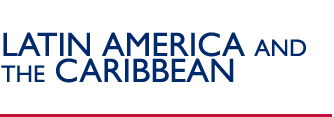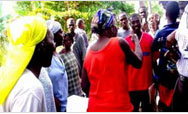
The income disparity in Panama is one of the highest in the hemisphere; the richest 20% of the population receives 63% of total income. This contrasts with Panama’s per capita income of $4,646, which ranks it as an upper-middle-income country.
Considering 37% of the population lives below the poverty line, much remains to be done to ensure that the benefits of an expanding modern, service sector reaches all its citizens.
Panama Snapshot
Date of Independence: 1821
Population: 3.3 million
Area: 75,517 Km2 or 30,193 m2
USAID IN PANAMA
http://www.usaid.gov/pa/ |

CONTACT INFORMATION
Mission Director
Kermit C. Moh
P.O. Box 0816-02561
Panama 5, Rep. Panama
(507) 207-7000
Panama Desk Officer (Washington)
Ebony Bostic
(202) 712-4721
E-mail: ebostic@usaid.gov |
|
Overview
Panama’s skyscrapers, vibrant banking and finance sector, and major ports give the impression of a country well able to meet the needs of it citizens. However, serious underdevelopment and security issues threaten Panama’s democratic institutions and political stability. With poverty levels high (37%) and deep-rooted, the economic and social well-being of many Panamanians, particularly those in the lower middle class, will worsen without sustained economic growth, equitable economic and social opportunities, and sustainable development. Panama’s key development challenges include i) fighting systemic corruption; ii) modernizing the judicial system to foster the rule of law and equitable access to justice; iii) consolidating its democracy; iv) maintaining the smooth administration of the economically vital Panama Canal and conserving the watershed that feeds it; and v) fostering the enabling environment necessary to increase trade and rural competitiveness while redressing widespread income inequality.
Programs
With USAID assistance, our partners in government institutions, civil society and select communities are carrying out environmentally-friendly income-generating activities, biodiversity conservation in protected areas, and environmental governance, through improved stewardship of natural resources and sustainable development.
Economic Growth
Maintaining the integrity of the Panama Canal Watershed (PCW) is critical to U.S. national security, world trade, and the Panamanian economy. Equally important is a more democratic and prosperous Panama, sharing the benefits of trade-led growth broadly among its citizens, thereby fortifying political stability in the region and ensuring the uninterrupted flow of international commerce through the Canal. By advancing economic freedom, USAID assistance to the private sector helps micro, small and medium-sized enterprises increase their productivity and competitiveness to take advantage of global trade opportunities.
USAID supports enhanced biodiversity conservation and natural resource stewardship to strategically offset major threats to the PCW through activities that encourage best natural resource management practices, policy reforms and adoption, and the active participation and empowerment of stakeholders, while encouraging eco-friendly income- generating opportunities.
Ruling Justly and Democratically
Panama has experienced 17 consecutive years of political stability with successive, democratically-elected governments. The current administration governing Panama manifests its commitment to fight corruption, and works towards that end. Yet, lack of transparency and inconsistencies in applying the rule of law persist, which thwart domestic and foreign investment flows. USAID assistance seeks to help Panama consolidate its still developing democracy through activities that support community empowerment, alternative dispute resolution, and environmental governance. We support seminal activities by the Citizens’ Alliance for Justice Reform, a coalition of 15 civil society organizations that advocates for critical judicial reforms and improved governance. In addition, we work with civil society at the grass roots level to strengthen advocacy and oversight capabilities to galvanize public support for fundamental reforms.
Collaborative Assistance Focused on Stakeholders
By creating public-private partnerships to help remove constraints and create opportunities, USAID improves rural and global competitiveness as it works with micro, small and medium-sized enterprises. USAID collaborates closely with communities, local authorities, government agencies, and non-governmental organizations to develop and implement strategic partnerships and alliances, participatory methodologies, best practices, and appropriate policies and regulations for optimal results in its Economic Growth and Ruling Justly and Democratically programs. Resource leveraging through strategic alliances and non-traditional partnerships has become a mainstay of these programs.
|


